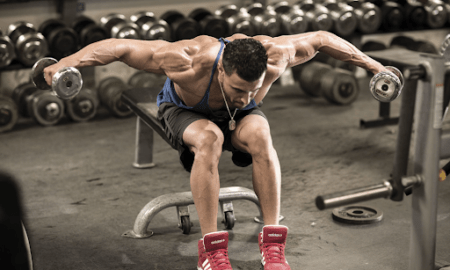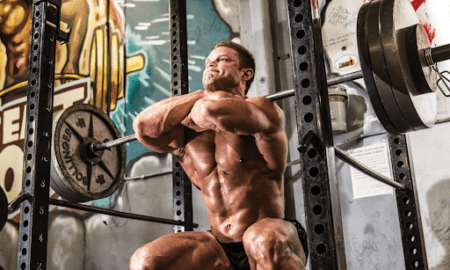Q: I’m a police officer in New Jersey, and I work a rotating two-week shift of 12-hour days. I read the article you wrote on over-40 bodybuilding training, which was awesome. I recently turned 40 and noticed that taking the rest days truly does help. I was wondering if you had a suggestion for a training routine that would fit my schedule. My work schedule looks like this:
Monday, Tuesday: Work 6 a.m. to 6 p.m.
Wednesday, Thursday: Off
Friday, Saturday, Sunday: Work 6 a.m. to 6 p.m.
Monday,Tuesday: Off
Wednesday, Thursday: Work 6 a.m. to 6 p.m.
Friday, Saturday, Sunday: Off
A: I’m not sure what type of training routine you’re following now or how many days of rest you take between muscle groups, but I think I can come up with a good program to fit your work schedule. Because you work 12-hour shifts, I’m sure you want to be able to go to the gym on your days off.
You could split your muscle groups up over three days before taking a rest. If you took two days off after three consecutive days of training, you would be resting each muscle group for five days before training it again.
Here’s an example of how you could split up your muscle groups:
Day 1: Chest, triceps, biceps, calves
Day 2: Abs, legs
Day 3: Delts, back, calves
Day 4: Rest
Day 5: Rest
That’s a good split to follow because there’s no overlap with the different muscle groups, so you won’t have to worry about overtraining any bodyparts. It’s also a good idea to train legs between the upper-body days because it gives those muscle groups a day of rest.
To fit that split into your 14-day work schedule, you could train three days on/two days off, three days on/two days off, three days on/one day off:
Work Schedule Training
Monday, work Rest day
Tuesday, work Rest day
Wednesday, off Day 1 workout
Thursday, off Day 2 workout
Friday, work Day 3 workout
Saturday, work Rest day
Sunday, work Rest day
Monday, off Day 1 workout
Tuesday, off Day 2 workout
Wednesday, work Day 3 workout
Thursday, work Rest day
Friday, off Day 1 workout
Saturday, off Day 2 workout
Sunday, off Day 3 workout
Using this schedule, you have to work out on only two of the days that you’re on duty in your 14-day rotation. The rest of your workout days will take place on your days off. That should accommodate your schedule and let you make your workouts more intense and productive.
You could cycle two heavy workout rotations with one moderately heavy rotation. When you’ll be taking two rest days after the training cycle, train heavy—six to 10 reps—for the three preceding workouts. When you’ll be taking only one rest day after the training cycle, go a little lighter and use higher reps—10 to 15—for more of a pump workout.
That will help you to recuperate and avoid overtraining. It will also be a welcome break after heavy training three days in a row for the past two workout cycles. Good luck!
Q: I’m a 53-year-old bodybuilder. I worked my way up to the Nationals and retired in 1986—didn’t want to use steroids. I hurt my shoulder doing decline Smith-machine presses four months ago. It’s been getting better slowly; I still can’t do dumbbell flyes, but I can do pec deck flyes. Any kind of free weights are very hard, and machines seem to be okay. Is that length of time normal? I don’t want surgery if I don’t have to have it. Also, I’ve been doing rehab exercises five times a week, a few minutes a day. Any help would be great.
A: Decline presses are pretty stressful on the shoulders. Doing them on a Smith machine can be even more stressful because the muscles are locked into a set position by the machine. If you were using free weights—barbells or dumbbells—on the exercise, your body would pick the groove that would be comfortable for your structure. With a machine, you have to do the exercise according to the setup of the machine.
I recommend that you seek professional help for your shoulder injury. I’m not sure what rehab exercises you’re doing, but if the injury is taking that long to heal, getting therapy will probably speed up the healing process.
If the shoulder is getting better, you probably didn’t do any severe damage—tear the rotator cuff, etc.—but you won’t really know until it’s examined by a medical professional. My guess is that it’s just a strain or pull to the muscle or the tendons and ligaments that surround the shoulder.
A good chiropractor or sportsmedicine doctor in your area should be able to treat the injury with ultrasound and electrical stimulation. Those methods will help bring more blood into the injured area and help it to heal faster.
As for your training, when you’re rehabbing your shoulder, only do exercises that don’t hurt that shoulder. Don’t try to “work through the pain.” That will only make the injury worse and delay the healing process. If you can find exercises to train your chest and shoulders that do not hurt, stick with them until you consult with a medical professional.
Q: I recently listened to your natural bodybuilding radio show, and it was really inspiring. I’m 19 years old and just decided to start bodybuilding. I have been lifting since I was 16, but I’m having a hard time coming up with a solid program for putting on mass. I’m eating 500 more calories than I need every day, but I think I lack the program I need for putting on some solid size. I’m 5’8”, 165 pounds with 11 percent bodyfat. If you have any workout advice that would help me put on mass, I would appreciate it. I plan on training natural, and I’d like to enter a contest a year from now, after I put on some size. Any advice?
A: Thanks for listening to my new Internet radio show. The show can be accessed online at www.NaturalBodybuildingRadio.com. We feature interviews each week with natural bodybuilding champions, contest promoters and writers, such as IRON MAN’s own Jerry Brainum.
I think a lot of teenage bodybuilders are in the same situation you are. When you’re young, your metabolism is going very fast, and it’s often difficult to add mass. That’s why so many people turn to anabolic steroids to help them get past their sticking points. They don’t know how to add the muscle naturally, and they believe that the only way to get big is to use the drugs.
You’re on the right track by increasing your calories. By eating 500 calories more than you normally eat, you’re giving your body more growth-producing nutrients. Just make sure those calories come from good bodybuilding foods and not useless junk food that’s loaded with fat, sugar and salt and is low in protein or complex carbohydrates.
Eat high-quality, complete forms of protein with each meal. Eggs, beef, chicken, fish, turkey, milk and cheese will give you the building materials for new muscle mass. If you ate approximately 1.25 to 1.5 grams of protein for each pound of bodyweight, you’d be getting 206 to 248 grams of protein a day. By eating six small meals per day and including a complete form of protein with each meal, you should be able to get in all the protein you need.
It’s also extremely important to eat plenty of complex carbohydrates when you’re trying to gain quality bodyweight. Whole-wheat bread, sweet potatoes, baked potatoes, whole-wheat pasta, brown rice, beans and corn will supply the energy that your muscles need for your heavy workouts and help you add quality mass. When I was trying to get bigger, I ate two to three grams of carbs for each pound of bodyweight. At 165 pounds you should get 330 to 500 grams of carbohydrates a day.
I’ve got a good workout program for you to follow during your bulking period. Split up your muscle groups over three workouts and take plenty of rest days per week. Concentrate on using the basic exercises with mostly barbells and dumbbells. Use a weight that really challenges you to do six to eight repetitions—the rep range that will build the greatest amount of muscle.
Day 1: Chest and Arms
Barbell bench presses 4 x 10, 8, 6, 6
Incline dumbbell presses 3 x 8, 6, 6
Flat-bench flyes 3 x 10, 8, 6
Pushdowns 3 x 10, 8, 6
Lying extensions 3 x 8, 6, 6
Weighted parallel-bar dips 3 x 6-8
Incline curls 3 x 10, 8, 6
Barbell curls 2 x 8, 6
Standing calf raises 4 x 12, 10, 8, 6
Day 2: Abs and Legs
Hanging knee raises 2 x 30
Incline situps 2 x 30
Squats 5 x 10, 8, 6, 6, 6
Leg presses 4 x 12, 10, 8, 8
Leg curls 3 x 10, 8, 6
Stiff-legged deadlifts 3 x 8, 6, 6
Day 3: Delts and Back
Seated military presses 4 x 10, 8, 6, 6
Lateral raises 3 x 8, 6, 6
Bent-over lateral raises 3 x 8, 8, 6
Barbell shrugs 4 x 10, 8, 6, 6
Wide-grip chins 3 x 10, 8, 6
Barbell rows 4 x 10, 8, 6, 6
Deadlifts 3 x 8, 6, 6
Wrist curls 3 x 12, 10, 8
Seated calf raises 4 x 20, 15, 12, 12
In order to get the proper amount of rest, you should give each bodypart five days off before training it again. You’ll have more energy for your workouts and grow more if you don’t train three days consecutively. Taking rest days between your workouts will enable more growth to take place. Here’s how the schedule lays out:
Day 1: Chest and arms
Day 2: Abs and legs
Day 3: Rest
Day 4: Delts and back
Day 5: Rest
Day 6: Repeat cycle
If you train very hard by making the workouts progressive—adding more weight or more reps each week—you should make great gains on the program. Remember to eat lots of complete-protein foods and complex carbs every day to feed those growing muscles, and you should be adding size to your physique in no time!
Editor’s note: John Hansen has won the Mr. Natural Olympia and is a two-time Natural Mr. Universe winner. Check out his Web site at www.NaturalOlympia.com, or send questions or comments to him via e-mail at [email protected]. Look for John’s new DVD, “Natural Bodybuilding Seminar and Competitions,” along with his book, Natural Bodybuilding, and his training DVD, “Real Muscle,” at his Web site or at Home Gym Warehouse, www.Home-Gym.com. Listen to John’s new radio show, Natural Bodybuilding Radio, at www.NaturalBodybuildingRadio.com. You can send written correspondence to John Hansen, P.O. Box 3003, Darien, IL 60561. IM




















You must be logged in to post a comment Login